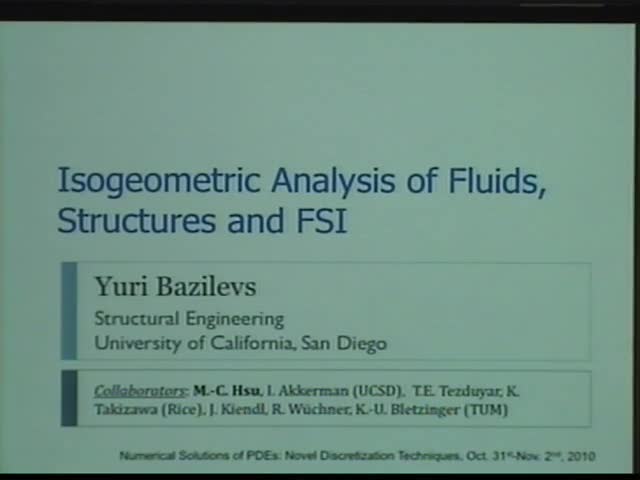Isogeometric Analysis of Fluids, Structures and Fluid-Structure Interaction
Presenter
November 4, 2010
Keywords:
- Computer graphics
MSC:
- 65D18
Abstract
Isogeometric Analysis [1] is a recently developed novel discratization technique that is based on the basis functions of computer-aided design and computer graphics. Although the main motivation behind the development of Isogeometric Analysis was to establish a tighter link between geometry modeling and computational analysis procedures, the new technology demonstrated better per-degree-of-freedom performance than standard finite elements on a broad range of problems in computational mechanics. This better "efficiency" of isogeometric analysis was attributed to more accurate analysis geometry definition and higher-order smoothness of the underlying basis functions. In this presentation, I will give an overview of the early developments in isogeometric analysis of fluids and structures. I will aslo give a summary of approximation results for the function spaces employed in isogeometric analysis. In the main body of the presentation I will show our recent work on isogeometric shell structures, turbulence modeling and fluid-structure interaction (FSI). I will conclude by presenting our recent isogeometric FSI simulations of a wind turbine rotor operating under realistic wind conditions and at full spatial scale in 3D [2,3].
References
[1] J.A. Cottrell, T.J.R. Hughes, and Y. Bazilevs, “Isogeometric Analysis. Toward Integration of CAD and FEA”, Wiley 2009.
[2] Y. Bazilevs, M.-C. Hsu, I. Akkerman, S. Wright, K. Takizawa, B. Henicke, T. Spielman, and T.E. Tezduyar, “3D Simulation of Wind Turbine Rotors at Full Scale. Part I: Geometry Modeling and Aerodynamics”, International Journal of Numerical Methods in Fluids, (2010). Published online.
[3] Y. Bazilevs, M.-C. Hsu, J. Kiendl, R. Wuechner and K.-U. Bletzinger, “3D Simulation of Wind Turbine Rotors at Full Scale. Part II: Fluid-Structure Interaction”, International Journal of Numerical Methods in Fluids, (2010). Accepted for publcation.
